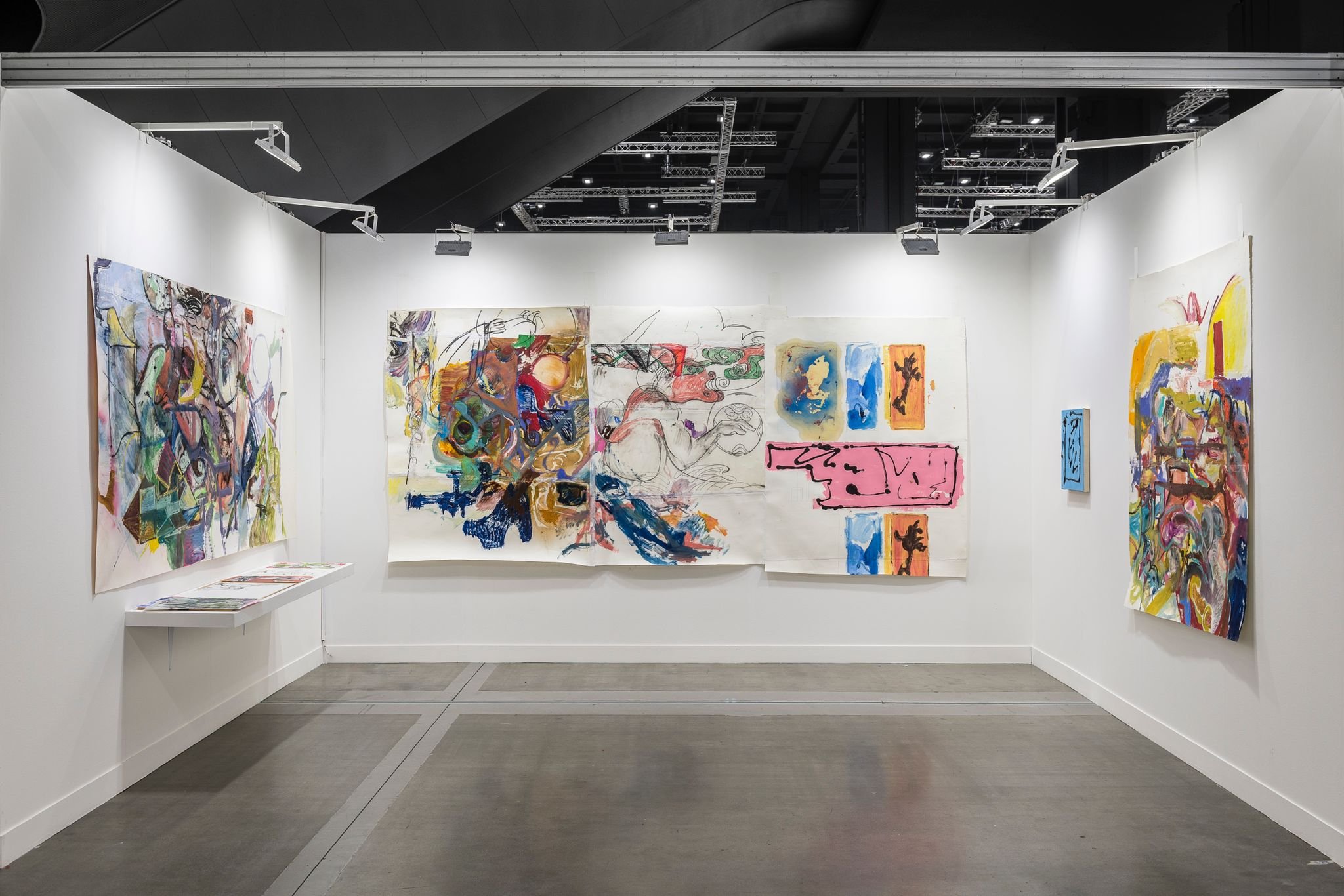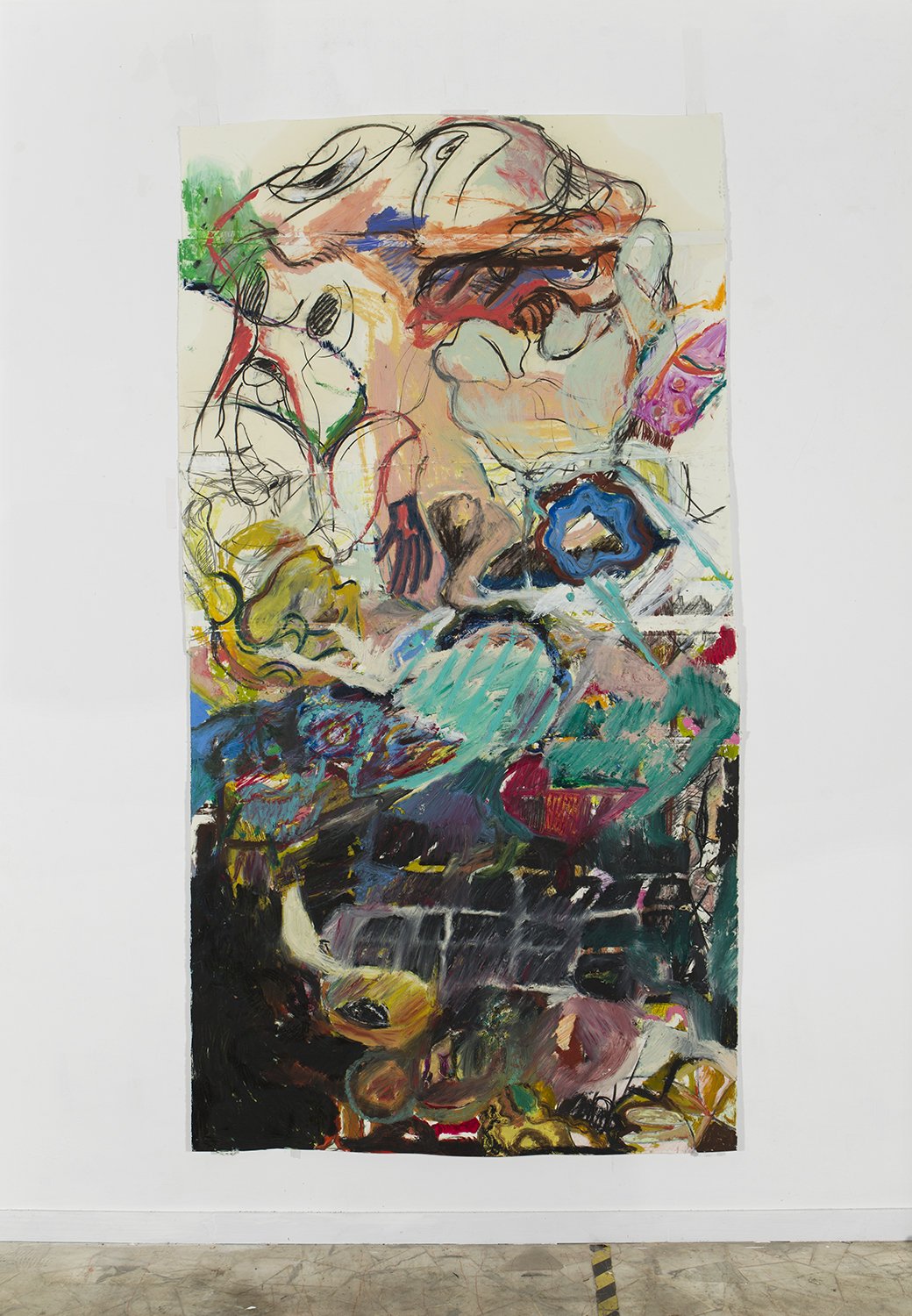Pesce Khete, Solo at Miart with COLLI, 2022
Pesce Khete, SINOSSI (Bon voyage), COLLI | Rome, 2020
OLDIES but GOLDIES, curated by Cecilia Canziani, COLLI | Rome, 2024
Pesce Khete, MART Museum, Rovereto, 2021

SINOSSI (Bon voyage)
Michele Tocca
ATPdiary
Pesce Khete’s painting is all in the wrist. Quite literally, the more you look at his works, the more his actions make you think of a wrist that rotates, flexes, extends, deviates, stiffens, sags, articulates. On the one hand, it is a matter of mechanics and technique: Pesce Khete uses oil-sticks, pastels, charcoals, spray cans. He comes from drawing, draws spasmodically, would never abandon paper even with a gun at his face. Paper imposes choices or, vice versa, follows the making of a piece. This explains the fragmentary nature of his surfaces, often assemblages of sheets that are gradually added according to execution exigencies. They are joined together by the same tape they are hung and displayed with, emphasizing their gravity and tension, at times, even the waves of the sheets once unrolled. Paper itself goes back to a dimension of planning and improvisation that motivates and contrasts pictorial rendition altogether. On the other hand, leaving mechanics behind, to paint is for Pesce Khete a perennial strive for a balance between having the finger on the pulse and the contrary. Over the years, in effects, the artist has done everything to baffle painting. Beginning with the nom de guerre, he has gone for various mystifications. He has convinced himself and others to be a draftsman. He has plunged headlong in analogical photography as an imaginative alter ego of painting. He has pursued the principle of contradiction, through which, for example, to resort to brut is a way to indulge in a sumptuous, consistent painting. He has proceeded by obstacles and self-imposed delays – limitations, that burst into a strenuous creative speed. These are ways for him to chase and problematise painting, alternating mystification and demystification without ever taking paint out of his mind. And, even harder, without diminishing or simulating it.
In the solo exhibition Sinossi (bon voyage) at Colli Independent Art Space, Rome, there is a canvas too. As with paper, canvas imposes its texture, it is thick jute, it affirms to be canvas, stretcher, object – perhaps still an alien presence, more of a sort of ‘Where is Wally?’. The surface is traversed by a black trajectory, acrylic and vinyl glue. It looks nonsense, though it is a mimetic reconstruction of the traces of glue left after removing billboards, posters and illegal signs seen around town. It is not just yet another reference to paper. Nor does it simply stand for a pictorial zeroing, a repression of the image – one immediately thinks of such artists as Mario Schifano and Mimmo Rotella. It is instead one of the escamotages to bite the tail of the dragon, that denotes an exhibition with no easy escape if not from a series of clichés on painting and its perception – those standards one usually clings to in order to try to understand and explain it. Five years after his last solo, the selection of large papers, the artist’s signature work, makes it clear that Pesce Khete’s intention is to dispel any possible doubt on what they seem and are. They are not expressionists but they search for expression, testing the notion of style more decisively – they are attempts, variations rather than stylistic experimentations. Style is in the continuous lengthening and narrowing the figural distances among pieces made either in the same period or in different years, for example, Untitled (2019) and Senza Titolo (O Istruzioni n.2) of 2017. The former seems convoluted but it is based on a solid composition (see the movement of the profiles of the heads and the limbs); the latter, at first calculated and essential, is instead deliberately casual. Order/chaos, composition/casualness are just two of the polarities that serve to focus the attention on painting qualities, the semantic and metaphoric shifts that, each time, mess up such general ideas as figuration and abstraction, rigour and spontaneity. In their brusqueness, the four smaller works on view, mixed media on paper and vellum, exacerbate this metamorphic process at the expense of a certain narrative taste that derives from the artist’s long-term acquaintance with vignettes, comics and illustration. Tape, in this respect, finds a more explicit collocation. In the exhibited works, it takes on a variety of tropes: it is necessary support, framing device, signifier, even absence when the eye continues to see it in the empty areas as in Untitled (2018-2019). Mainly, it reminds of a physical storyboard in its role of conjunction, partition and multiplication of image levels, breaking, syncopating or interrupting the narrative tension. The tangles of figures and objects involve themes like everyday survival, construction activities, daily accidents and rituals. Hands and eyes recur as if evoking sensory perception. Phallic or vaginal shapes, anatomical allusions to lips or anuses subtend sexual intercourses. Though, everything is overlapped, stuck up, centrifuged in a wild and automatist anti-narrative that eventually resolves in the “picture-within-picture” dynamics. One might seize a logic, thinking of a lineage that goes through Munch’s variations on the theme and Picabia’s transparencies, Albert Ohelen’s collisions and Ansel Krut’s art-historical pulping. Yet his remain indecipherable visions, before which the prevailing feeling is to be mired in a magmatic and vernacular world outside, identifying its indomitable and unexpected flux with the unattainability of painting. The interweaving of images and pictorial means, of events and the studio, the life pulse, distinguishes these works from a lingua franca spoken by much international painting that aims at an escapist visionariness, dense with erudite quotations and highly accomplished aesthetic expectations. In Pesce Khete’s, we are in a seamless, unsolvable territory of non-hierarchical observations, unconscious associations and conscious analogies between “the street” and “the studio”. And when the street enters, disseminates and stratifies in the studio so viscerally, the rubber and pencil shavings left in a work say the same things as the depiction of what looks like a tumble down the stairs.
Pesce Khete, MART Museum, Rovereto, 2021

















